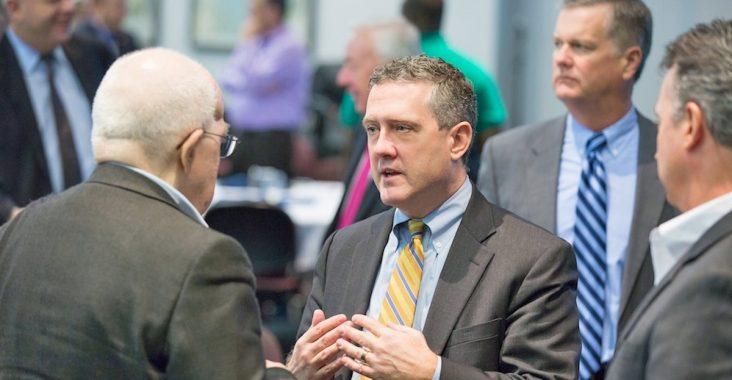St. Louis Fed Chief warns against rate hikes, calls FOMC normalization policy ‘unwise’
by February 19, 2016 1:28 pm 514 views

Federal Reserve Bank of St. Louis President James Bullard (center) spoke with members of the audience after a Nov. 20, 2015 speech in Fort Smith. (photo courtesy of the Federal Reserve Bank of St. Louis.)
St. Louis Federal Reserve President James Bullard this week criticized the Federal Reserve Open Market Committee’s normalization policy, calling it “unwise” to continue the central bank’s monetary policy for continued interest rate hikes with recent declines in inflation expectations caused by declining oil prices.
The president of the expansive Eighth District, which includes Arkansas and portions of Illinois, Indiana, Kentucky, Mississippi, the eastern half of Missouri and West Tennessee, made his observations Wednesday in a presentation to the CFA Society of St. Louis called, “Changing Imperatives for U.S. Monetary Policy Normalization.”
Bullard, one of 10 members of the FOMC chaired by Fed Chief Janet Yellen, said renewed downward pressure on market-based measures of inflation expectations during 2016 has called the current policy into question.
“I regard it as unwise to continue a normalization strategy in an environment of declining market-based inflation expectations,” he stated.
Bullard, one of the more influential regional Federal Reserve chiefs, said the FOMC’S case for monetary policy normalization in 2015 rested on several key assumptions and two of these assumptions have now been called into question in 2016: stable inflation expectations and the potential for asset price bubbles. In particular, he said market-based inflation expectations have fallen further and that the risk of asset price bubbles over the medium term appears to have diminished.
“These data-dependent changes likely give the FOMC more leeway in its normalization program,” he said.
Regarding the economic outlook, Bullard said U.S. growth and labor market prospects remain reasonable. He said lower long-term interest rates resulting from the recent financial market turmoil are an automatic stabilizer that should support growth. Bullard also discussed the need for monetary policy to be more clearly data dependent and whether the FOMC should rethink its approach to the Summary of Economic Projections (SEP).
“The Committee may wish to consider changes to the way it approaches the policy rate projections in the SEP to better align market expectations of future policy moves,” he said.
He also said modern theory suggests inflation expectations are a more important determinant of actual inflation than traditional “Phillips curve” effects, whereby further gains in labor markets put upward pressure on inflation. He noted that the decline in market-based measures of inflation expectations in the U.S. since the summer of 2014 has been highly correlated with the decline in oil prices.
“I suggested during 2015 that inflation expectations would return to previous levels once oil prices stabilized,” Bullard he said. “Since then, inflation expectations have declined too far for comfort, the oil price correlation notwithstanding.”
As the chief executive of the Federal Reserve Bank of St. Louis. Bullard participates in the Federal Open Market Committee (FOMC) and directs the activities of the Federal Reserve’s Eighth District. His comments this week has some economy watchers predicting that the FOMC will tighten up federal money policy at the March meeting after decided at the end of 2015 to raise the target range for federal funds rates for the first time in nine years to 0.25% to 0.50%.
Other highlights of Bullard’s presentation, which are posted at the St. Louis Fed’s website, include the following:
• Asset price bubbles
Bullard said the risk of asset price bubbles over the medium term has been reduced.
“Steps toward normalization of U.S. monetary policy help to lessen the risk that very low interest rates might feed into a third major asset price bubble in the U.S.,” Bullard said. “The recent sell-off in global equity markets, along with increases in risk spreads in corporate bond markets, may have made this risk less of a concern over the medium term.”
• U.S. growth and labor market prospects
“I expect 2016 U.S. economic growth to be stronger than last year, and I expect U.S. labor markets to continue to improve,” Bullard said, adding he also expects global growth to be stronger in 2016 than in 2015.
In addition, the St. Louis Fed chief noted that one aspect of the financial market turmoil during the last two months is that U.S. longer-term interest rates have fallen. “This is a bullish factor for the U.S. during 2016,” he said.
• The FOMC and data dependence
Bullard said the FOMC has repeatedly stated in official communication and public commentary that future monetary policy adjustments are data dependent. He then addressed the possibility that the financial markets may not believe this since the SEP may be unintentionally communicating a version of the 2004-2006 normalization cycle, which appeared to be mechanical.
“The policy rate component of the SEP was perhaps more useful when the policy rate was near zero, and the Committee wished to commit to the idea that the policy rate was likely to remain near zero for some period into the future,” Bullard explained. “But now, post liftoff, communicating a path for the policy rate via the median of the SEP could be viewed as an inadvertent calendar-based commitment to increase rates.”
Bullard said this is an important issue for the FOMC to now consider.
The FOMC could change its approach to the SEP in a way that would cease giving such explicit guidance on the likely path of the policy rate going forward,” he said. “Such a change might help better align the Committee with financial markets on the idea that policy is data dependent and does not follow a predetermined path.”
